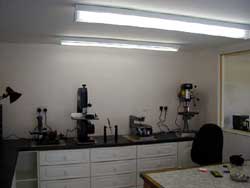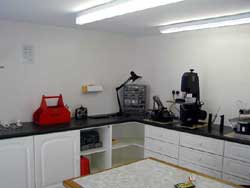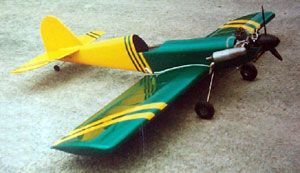
Member Profiles and Other Items.
On Sunday 11th September we had one of the best flying days of the Autumn. It was on this fine day that Anna McDonagh, one of our lady members, along with other disabled members of the club, took to the air for the first time with the most magnificent flying machines I have ever built in my life! Anna proved to be something of a natural for someone who had not flown a model before.
David Furneaux and Alan Forrest checked the radio installation for us and trimmed the model out, our sincere thanks miust go to these two brilliant experts for their assistance.
The model was originally donated to the disabled group by Alan Forrest, the safety officer and webmaster, it is made from "Corex" material and is virtually unbreakable, you can virtually drive your car over the model with no damage whatsoever, it comes with two nylon props so there is little more to do than to complete the assembly and install your engine and radio, we are currently using an Irvine 25 ABC.
The "Prangster" was designed by Robert Newman of Avicraft in Kent, a very old friend of Alan's.
On that very same day Alan was flying his "Panic", expertly I might add, which was designed many years ago by Phillip Newman, Roberts brother, Phillip died some four years ago as the result of a tragic accident. Alan's "Panic" is a fabulous piece of machinery, with flaperons (and everything else coupled!!) it's powered by an "Irvine" 72 and really moves!!
Long may we fly these great models... Happy Landings
George Wenham
EI 3873
Some thoughts on Landings and a few fond Memories.
I was at the field a few weeks, ago when one of our juniors was attempting a downwind dead stick landing, the model was travelling quite fast and the lad called to me with the question "can I turn", under instruction he put the nose down and then performed a really nice turn culminating into an impressive flare onto the patch. Whilst driving "herself" to Dublin the next day for a shopping expedition my thoughts turned to my own experiences and my early attempts at landing.
In those days I flew gliders on the multitude of soaring sites In South East England. I well remember those early days attempting to learn to fly, one of my early recollections was sitting on top of the slope at the Long Man at Wilmington, near Eastbourne, I was feeling a bit sorry for myself at being unable to get airborne, when two young lads came up to me and offered their assistance, they carried with them two of the most immaculately finished flying machines I had ever seen, beautiful open structure airframes covered in transparent nylon. They proceeded to give me a few lessons and managed to get me solo, more or less, within a couple of hours. My thanks to those two great guys was immeasurable, especially when I later discovered that their gliders were the prototype Phase one's and I had been in the company of, and had received lessons from, Chris Foss and Ken Binks! The art of flying into the slope at breakneck speed, performing a very fast aileron turn into wind, to kill the speed, and settling onto the deck, was well demonstrated and learned that day, however a year or so later I had to go back to school, read on!!
I
must have been one of the first people that was sent the, then new, Access
credit card by my bank, it went into the wallet and was more or less forgotten
about until one day I found myself (as I often did) at 308 Holloway Road,
for those of you who might not of heard of this address, this was the
legendry model shop of Henry J. Nicholls and his son, Richard, if you
don't know who Henry "J" was then ask your elders!!
Whilst in the shop Henry showed me the very latest arrival from Germany,
a rather magnificent glider, virtually ready built, what I was looking
at was a Graupner Cumulus, this must surely have been the forerunner of
all of the ARTF's, built in Germany by craftsman and absolutely perfect
in all respects, and reflected in the price! I didn't have the funds to
purchase this beast and was about to leave 308 when I remembered the newly
arrived piece of plastic in my pocket, I asked Henry if he would accept
the card and, although he said yes, he had absolutely no idea on how to
use it, let alone part with a very expensive glider in exchange for a
piece of plastic, so off I went to the nearest branch of the National
Westminster Bank, I was most surprised to discover that they gave me the
cash to purchase the glider in exchange for my signature on a small slip
of paper, mind you they were very careful to phone my own branch to ensure
that I really existed and was not trying to commit a minor robbery!
Back at 308 I gave Henry the cash in exchange for his latest import, I
might add that he was a bit reluctant to part with it having just received
it himself! Arriving back home later that day I unpacked my latest acquisition,
the quality and craftsmanship in the Cumulus just had to be seen to be
believed, after a short time I had the model assembled and ready to fly
apart from covering. Tissue and dope was the order of the day, followed
by a sprayed black enamel finish. Radio installation was relatively simple,
the model using just two servo's for elevator and rudder. Come the weekend
I went, with a few of the lads, to Holly Hill, a great sloping site near
Rochester in Kent, the top of the slope was covered in a continuous long
line of very high trees making landings interesting no matter what type
of model you were flying, the Cumulus was assembled, range checked and
then launched off the hill, she flew out off of the slope with the majesty
one would expect from this type of model, after a few loops and low passes
it was time to land. Now the usual procedure at Holly Hill was to "crab"
the glider along the tree line and then to turn fully into wind when the
model would settle nicely onto the grass, boy, was I in for a shock, the
Cumulus was so aerodynamically clean she accelerated like a formula one
car as soon as you put any amount of down elevator, also her penetration
into wind had to be seen to be believed, there was only one way that this
glider was going to be brought safely to earth, and that was to walk all
the way down the hill to the fields at the bottom. After this experience
she was always flown on slopes, such as the Devils Dyke at Brighton, where
the top was clear of trees and you could get a little behind the ridge
to kill the lift. Models of this size are nearly always fitted with air
brakes these days, they make life much easier when landing on a ridge
with "restrictions". In the case of a powered model it is worth remembering
that if you go "dead stick" and you are upwind of the landing area, keep
the speed up on the downwind leg and use the power of the wind to stop
the model virtually dead by performing a fast aileron turn, fairly close
to the ground. I would suggest that you practice this technique at a good
height with your engine in tick over, you will be surprised at how, even
the "cleanest" model, can be brought to a virtual standstill in a matter
of a few feet especially in a moderate wind, perfection of the technique
will save you a long walk to retrieve the model, it also looks very impressive
when performed well.
Our junior member learned very fast last week that you certainly can turn your model on it's final dead stick approach to the patch provided that you are flying a downwind leg and that you have sufficient speed to complete the turn safely without tip stalling your model and, most importantly, you have practiced the manoeuvre at a safe height, and have the confidence in your model to perform the task! It's rather nice at my age when a small event such as observing a great landing provokes fond memories of early flying experiences.
Alan Forrest
James Lennon. MACI No. EI 2880
I
first entered the world of radio controlled model aircraft as a spectator!
At the tender age of seven I used to watch my father and David Ferneaux
flying most Sundays, hot weather permitting, I never managed to get my
hands on the controls at this early age, my main job was to retrieve the
model as it touched down, sometimes yards away and sometimes fields away!!
At the age of sixteen and with an Aircore 40 and Hi-Tec radio David took me under his wing and taught me how to fly my model, he was much more patient than my father. After going solo I practiced on my own and at the age of seventeen I achieved my "A" certificate, since those days I have flown Acrowots, Aero Stars and an Extra 300.
I am very much into aerobatics and practice this style of flying most Sundays at the clubs flying site in Longford, I hope to achieve my "B" certificate in the near future and may even try my luck in a novice aerobatic competition. One thing is certain, I enjoy my hobby immensely and could never imagine a time when I would not be flying my models.
Alan Forrest. MACI No. EI 3727
I
started aeromodelling way back in the early fifties, I well remember my
first project, a control line Keil Craft Champ, which never really took
to the skies. In later days, along with my pit man, John Revel, I succeeded
in
lifting
the S.M.A.E. gold trophy for control line Goodyear racing at Odiham, along
with a second place at
Cranfield in the same year, heady days!!.
My
entry into radio control came much later, starting with a Veron Impala
on the Long Man at Wilmington in Sussex,, that day I well remember, after
many unsuccessful attempts at flying the glider, two young men
offered me their assistance, little did I know that I was in the company
of Chris Foss and Ken Binks!! that
was very much a lesson to remember and started me off on the hobby of
a lifetime.
I
remember the young shop assistant at Avicraft, who gave me the benefit
of his advice on many occasions,
Jim Perkins his name was, ring any bells? that's right, Jim Perkins of
Perkins Distribution, Jim has become
a lifelong freind. At that time the late Phillip Newman was playing around
with a new design, which turned out
to be that all time classic "The Panic", I was indeed fortunate
to witness the development of this fabulous
model. Phillip died in a tragic accident four years ago.
Throughout
the years I have been privileged to have known many of the characters
on the modeling scene,
names such as Tony Lunt, Bunny, Alistair, Robert and, of course Phil Newman,
Chris Foss, Kenny Binks
are all names that spring to mind.
I
moved to Ireland in the early nineties, I virtually gave up modelling
due to the lack of clubs and fliers in the Kilkenny region, where I lived
at the time, recently I have found kindred spirits in the Longford modelling
club,
I am now in the process of building my "dream" workshop which
had always been an ambition right from the
early days. I now look forward to spending many hours building the models
that I know are in me and enjoy the company of my new found friends here
in Ireland. My current lack of appearances at the field on Sundays is
due to my singular purpose of getting the workshop finished.
I finished my new workshop on 31st July and am building like mad!! here are a couple of pictures:


I hope to be back "In Harness" this coming Sunday 5th August it'll be nice to "twiddle" the sticks again!
Their
is no better hobby for a youngster to persue these days, I am totally
committed to the LMAC policy of bringing awareness of the sport to local
people and passing on the experience and skills of the existing
members to them, that way we will all do our bit towards giving the younger
generation something worthwhile
and constructive to persue in their spare time!!
From the annals of The Longford Model Club
Little Lost Zack!...
By Jon Etherton founder member.
In the summer of "94" during one of those rare calm evening's,
some of our more dedicated Aeromodellers ventured out to fly (after all
how many of us are there that do not get the urge to get airbourne on
a fine evening).
Anyway
this is a tale about a model plane called "Zack". During the
evening in question "Zack" was being put through it's paces
by its capable pilot and suddenly whilst pulling out of an inverted pass
"Zack" apparently terminated it'spower supply to the receiver
and continued to fly whilst still inverted towards a
nearby area of what can only be described as a "jungle", we
are talking about an area of untouched bogland with foliage akin to that
which you can expect in the Amazon Rainforest, as we duly found out.
We
made several sorties in search for "zack", all to no avail and
all we had to show for it were insect bites and wet feet!. The ferns were
up to six feet high which made finding a small model plane virtually impossible,
the only hope being that we might have stumbled across it or get a glimpse
of it's bright yellow flash through
the dense undergrowth, in which you could almost hide a full size aircraft,
not to mention a mere 42" "Zack"
The summers day's were passing and we beginning to give up on ever finding "Zack" and our dedicated comrade had decided to hang up his transmitter for the rest of the year, as losing "Zack" had been the final straw , in one of those year's flying which was better forgotten (nearly all of us have had one!).
All
ground searches had failed and it was time to try an aerial view and we
gratefully accepted an offer from the owner of a light aircraft (full
size) to havea look for the model. During a brief overfly of the area,
something yellow was sighted could this be "Zack" ?
In order to confirm the location, we set out armed with a trainer with an onboard camera, we also had the benefit of two way hand held radio's to ensure that the photo's were taken in the area that the yellow object had been sighted. One of the photos revealed a yellow dot, which was obviously the thing that had been sighted from the full size aircraft. We had hope at last, alas the yellow object turned out to be a fertilizer bag which was partly covered by grass!!
We decided to wait for the foliage to recede during the winter before resuming our search in the hope that "Zack" would be easier to find. The only consolation was that we knew that "Zack" was not far away, but it had been like looking for the proverbial needle in a haystack.
During
the winter months the occasional search was carried out and eventually
persistance paid off, "Zack" was found in January '95 by one
of our more energetic members, whose speciality is searching and usually
finding lost planes (no hints intended). Whilst standing at the edge of
a drain which was overgrown with weeds,
he happened to spot a small piece of solarfilm at it's edge, he looked
into the drain and could just about see "Zack", it had burried
itself into the drain and unfortunately had shed it's internals on impact.
"Zack was brought home by it's somewhat relieved owner, however it had soaked up a lot of water and had increased it's weight about tenfold, having been exposed to the elements for most of the winter, but some parts were salvaged and all was not lost.
Our
Comrade had kept his word, when he declared that he would not fly for
the remainder of that year, but the fact that he was busy at the building
board just after loosing "Zack" was enough to tell us that it
did not dampen his enthusiasm for the hobby. Therefore the timely return
of "Zack" was just the tonic need for a return to
the flying field for '95, of course we tell all daring pilots who fly
over this area,since named "The Bermuda Triangle", that they
do so at their own peril!!

Could the owner of "Zack" possibly have been our Hon Sec??? (Webmaster)